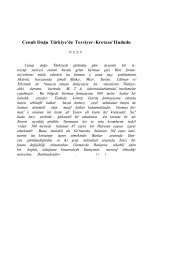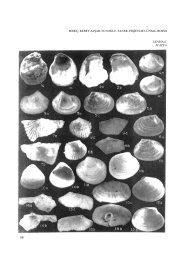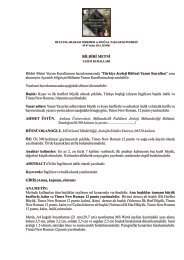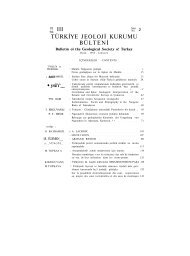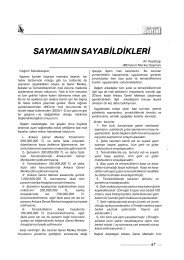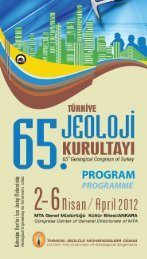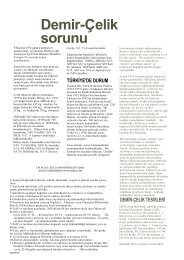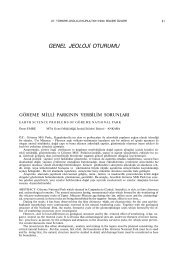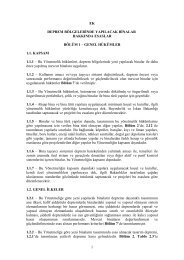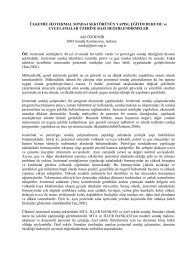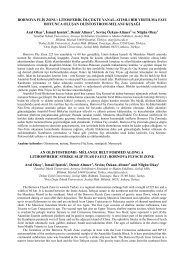Paleosismoloji ve Arkeosismoloji Palaeoseismology and ...
Paleosismoloji ve Arkeosismoloji Palaeoseismology and ...
Paleosismoloji ve Arkeosismoloji Palaeoseismology and ...
You also want an ePaper? Increase the reach of your titles
YUMPU automatically turns print PDFs into web optimized ePapers that Google loves.
62 nd Geological Kurultai of Turkey, 13−17 April 2009, MTA–Ankara, Türkiye<br />
Earthquake History <strong>and</strong> Slip Rate of Sapanca-Akyazı Segment<br />
on Western Part of North Anatolian Fault for the Past 1000 Years<br />
Aynur Dikbaş 1 , H. Serdar Akyüz 2 , Mustapha Meghraoui 3 , Matthieu Ferry 4 ,<br />
C. Çağlar Yalçıner 3,5 , Cengiz Zabcı 2 , Volkan Karabacak 5 , Nafiye Kıyak 6 & Erhan Altunel 5<br />
1 İstanbul Technical Uni<strong>ve</strong>rsity, Eurasia Institute of Earth Sciences, Maslak,<br />
TR−34469 İstanbul, Turkey (E-mail: adikbas@itu.edu.tr)<br />
2 Istanbul Technical Uni<strong>ve</strong>rsity, Faculty of Mines, Department of Geological Engineering,<br />
Maslak, TR−34469 İstanbul, Turkey<br />
3 EOST-Institut de Physique du Globe de Strasbourg, F-67084 Strasbourg, France<br />
4 Geophysical Centre, Uni<strong>ve</strong>rsity of Evora, PT-38043 Evora, Portugal<br />
5 Eskişehir Osmangazi Uni<strong>ve</strong>rsity, Department of Geological Engineering,<br />
Meşelik, TR−26480 Eskişehir, Turkey<br />
6 Işık Uni<strong>ve</strong>rsity, Physics Department, Maslak, TR−34398 İstanbul, Turkey<br />
The earthquake history of the eastern Marmara region is limited by the historical documents which<br />
indicate the felt area mostly as İstanbul <strong>and</strong> sometimes as İzmit. It is hard to determine the earthquakes<br />
that produced surface rupture in the east of İzmit only by searching the historical documents. There is<br />
no paleoseismological data in this part of North Anatolian Fault <strong>and</strong> research of paleoseismological<br />
data is important for underst<strong>and</strong>ing the earthquake history of the region. For this purpose, three sites<br />
on Sapanca-Akyazı segment were chosen for paleosismological in<strong>ve</strong>stigations. Sapanca-Akyazı<br />
segment is one of the fi<strong>ve</strong> segments ruptured on 17 August 1999 earthquake <strong>and</strong> the maximum rightlateral<br />
displacement (5.2 m) was measured on this segment. It trends along 25 km between the Lake<br />
Sapanca <strong>and</strong> Akyazı town with a strike of N85W. Paleoseismological in<strong>ve</strong>stigations re<strong>ve</strong>aled that the<br />
earthquakes of 27 May 1719 <strong>and</strong> 1 October 1567, <strong>and</strong> an earthquake which happened around year<br />
1000 had ruptured the segment.<br />
One the west of Sakarya ri<strong>ve</strong>r, an old terrace riser of the ri<strong>ve</strong>r is visible at the surface on the south of<br />
the fault zone <strong>and</strong> can not be obser<strong>ve</strong>d on the northern part. The northern part was in<strong>ve</strong>stigated by<br />
GPR (Ground Penetrating Radar) to check if the continuation of the riser was buried due to <strong>ve</strong>rtical<br />
mo<strong>ve</strong>ment on the northern part, <strong>and</strong> it is determined in the GPR profile. The cumulati<strong>ve</strong> displacement<br />
of the riser is measured as 18.5±0.5 m with teodolite. The OSL dating of the terrace riser re<strong>ve</strong>aled a<br />
slip-rate of 21.9±3 mm/year on the region for last 1000 years.<br />
Key Words: NAF, earthquake, Sapanca-Akyazı segment, paleoseismology, GPR, slip-rate<br />
1001



